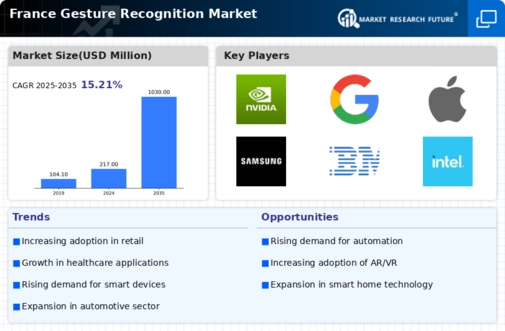Increased Demand for Contactless Interfaces
In France, The gesture recognition market is witnessing heightened demand for contactless interfaces. This trend is particularly evident in the wake of evolving consumer preferences. As individuals become more health-conscious, the desire for touchless technology in public spaces and personal devices is growing. This shift is evident in retail environments, where gesture recognition systems are being implemented to facilitate seamless transactions without physical contact. The market is expected to reach a valuation of €1 billion by 2026, reflecting a significant increase in investment in contactless solutions. This trend not only enhances user experience but also aligns with broader public health initiatives, positioning the gesture recognition market as a key player in the transition towards safer, more hygienic interactions.
Government Initiatives Supporting Innovation
In France, government initiatives aimed at fostering innovation are positively impacting the gesture recognition market. Various programs and funding opportunities are being introduced to support research and development in emerging technologies, including gesture recognition. These initiatives are designed to encourage collaboration between public and private sectors, facilitating the growth of startups and established companies alike. As a result, the gesture recognition market is likely to benefit from increased investment and innovation, potentially leading to breakthroughs in technology and applications. The French government has allocated €500 million towards digital transformation projects, which may include advancements in gesture recognition systems. This supportive environment is expected to stimulate growth and enhance the competitive landscape of the gesture recognition market.
Rising Interest in Augmented and Virtual Reality
The gesture recognition market in France is significantly influenced by the rising interest in augmented reality (AR) and virtual reality (VR) applications. As industries adopt these technologies, the need for effective gesture recognition systems becomes paramount. As industries such as gaming, education, and training adopt AR and VR technologies, the need for effective gesture recognition systems becomes paramount. These systems enable users to interact with virtual environments in a more immersive way, enhancing the overall experience. The market for AR and VR is expected to grow by 40% over the next five years, indicating a strong potential for gesture recognition technology to play a crucial role in these sectors. This trend suggests that as AR and VR applications become more mainstream, the gesture recognition market will likely expand in tandem, driven by the demand for more interactive and engaging user experiences.
Technological Advancements in Gesture Recognition
The gesture recognition market in France is experiencing a surge due to rapid technological advancements. Innovations in machine learning and artificial intelligence are enhancing the accuracy and efficiency of gesture recognition systems. This is particularly evident in sectors such as gaming and virtual reality, where immersive experiences are becoming increasingly popular. The market is projected to grow at a CAGR of approximately 25% from 2025 to 2030, driven by these technological improvements. As companies invest in research and development, the capabilities of gesture recognition systems are expanding, allowing for more sophisticated applications. This trend indicates a robust future for the gesture recognition market, as businesses seek to leverage these advancements to improve user interaction and engagement.
Expansion of Smart Technology in Consumer Electronics
The gesture recognition market is benefiting from the expansion of smart technology in consumer electronics. This trend is particularly evident across France. With the proliferation of smart TVs, wearables, and home automation systems, there is a growing need for intuitive control mechanisms. Gesture recognition technology allows users to interact with devices in a more natural and engaging manner. The market for smart home devices is projected to grow by 30% annually, creating a fertile ground for gesture recognition applications. This integration not only enhances user convenience but also drives the demand for advanced gesture recognition systems, as manufacturers seek to differentiate their products in a competitive landscape. Consequently, the gesture recognition market is poised for substantial growth as it aligns with the increasing adoption of smart technology.

















Leave a Comment